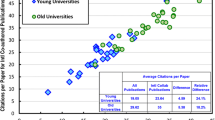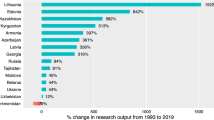Abstract
Many academic societies and universities entrust the publication of their open access journals to large publishers, and this collaboration strengthens the presence of these publishers in the open access journal market. This study empirically examines the effect of collaborating with large publishers on the internationality and influence of research institutions’ journals. The study compiles 60 Scopus-indexed open access journals and finds their citation frequency through the SCImago journal rank and source normalized impact per publication. Furthermore, it uses the country distribution of authors and citations to determine the journals’ internationality. The results revealed that most journals increased the number of articles written by overseas researchers and their citation scores, which indicates that collaborating with large publishers is an effective method for enhancing the internationality and influence of institutions’ official journals in non-English-speaking countries in particular. However, in addition to publishing journals on publishers’ websites, research institutions’ efforts toward internationality, such as appointing overseas researchers as editors, are essential to accomplish the desired outcome.


Similar content being viewed by others
Notes
While Universities UK (2015) reported that 212 out of 279 academic societies (76%) outsourced journal publication to publishers, Wise and Estelle (2020) stated that 72% of academic societies outsourced publications to publishers based on the sample studied.
The issue should be discussed using the number of articles submitted by authors, and not the number of articles published. However, the information regarding the number of articles submitted by the authors or the acceptance rate is not provided by most sampled journals.
References
Antelman, K. (2004). Do open-access articles have a greater research impact? College & Research Libraries News,65(5), 372–382.
BMC. (2014). BioMed Central society journals see increase in impact factors after their move to open access. Retrieved January 20, 2019, from https://www.biomedcentral.com/about/press-centre/business-press-releases/5-aug-2014.
Buela-Casal, G., Perakakis, P., Taylor, M., & Checa, P. (2006). Measuring internationality: Reflections and perspectives on academic journals. Scientometrics,67(1), 45–65.
Buela-Casal, G., Zych, I., Sierra, J. C., & Bermúdez, M. P. (2007). The internationality index of the Spanish psychology journals. International Journal of Clinical and Health Psychology,7(3), 899–910.
Busch, S. (2014). The impact factor of journals converting from subscription to open access. Retrieved November 6, 2014, from https://blogs.biomedcentral.com/bmcblog/2014/11/06/the-impact-factor-of-journals-converting-from-subscription-to-open-access/.
Clarke, M. T. (2020). The journal publishing services agreement: A guide for societies. Learned Publishing,33(1), 37–41.
Crawford, W. (2018). GOAJ3: Gold Open Access Journals 2012–2017. Retrieved March 27, 2019, from https://walt.lishost.org/2018/05/goaj3-gold-open-access-journals-2012-2017/.
Davis, P. M. (2009). Author-choice open-access publishing in the biological and medical literature: A citation analysis. Journal of the American Society for Information Science and Technology,60(1), 3–8.
Davis, P. M. (2011). Open access, readership, citations: A randomized controlled trial of scientific journal publishing. The FASEB Journal,25(7), 2129–2134.
Dorta-González, P., González-Betancor, S. M., & Dorta-González, M. I. (2017). Reconsidering the gold open access citation advantage postulate in a multidisciplinary context: An analysis of the subject categories in the Web of Science database 2009–2014. Scientometrics,112(2), 877–901.
Eysenbach, G. (2006). Citation advantage of open access articles. PLoS Biology,4(5), e157.
Frandsen, T. F. (2009). The integration of open access journals in the scholarly communication system: Three science fields. Information Processing and Management,45(1), 131–141.
Gasparyan, A. Y., Yessirkepov, M., Voronov, A. A., Koroleva, A. M., & Kitas, G. D. (2019). Comprehensive approach to open access publishing: Platforms and tools. Journal of Korean Medical Science,34(27), e184.
Harzing, A. W., & Alakangas, S. (2017a). Microsoft academic: Is the phoenix getting wings? Scientometrics,110(1), 371–383.
Harzing, A. W., & Alakangas, S. (2017b). Microsoft academic is one year old: The Phoenix is ready to leave the nest. Scientometrics,112(3), 1887–1894.
He, T. (2003). Difficulties and challenges of Chinese scientific journals: Statistical analysis of Chinese literatures using Chinese Science Bulletin as example. Scientometrics,57(1), 127–139.
He, T., & Liu, W. (2009). The internationalization of Chinese scientific journals: A quantitative comparison of three chemical journals from China. England and Japan. Scientometrics,80(3), 583–593.
Ilva, J. (2018). Looking for commitment: Finnish open access journals, infrastructure and funding. Insights,31(25), 1–9.
Laakso, M., Solomon, D., & Björk, B.-C. (2016). How subscription-based scholarly journals can convert to open access: A review of approaches. Learned Publishing,29(4), 259–269.
Lansingh, V. C., & Carter, M. J. (2009). Does open access in ophthalmology affect how articles are subsequently cited research? Ophthalmology,116(8), 1425–1431.
Lawrence, S. (2001). Online or invisible? Nature,411(6837), 521.
Li, L., & Zhang, F. (2003). Developing English-language academic journals of China. Scientometrics,57(1), 119–125.
McCabe, M. J., & Snyder, C. M. (2014). Identifying the effect of open access on citations using a panel of science journals. Economic Inquiry,52(4), 1284–1300.
Morrison, H. (2018). Global OA APCs (APC) 2010–2017: Major trends. Retrieved March 27, 2019, from https://elpub.episciences.org/4604/pdf.
Ren, S., & Rousseau, R. (2002). The role of China’s English-language scientific journals in scientific communication. Learned Publishing,17(2), 99–104.
Solomon, D. J., Laakso, M., & Björk, B.-C. (2016). Converting scholarly journals to open access: A review of approaches and experiences. Retrieved November 15, 2019, from https://dash.harvard.edu/handle/1/27803834.
Sotudeh, H., Ghasempour, Z., & Yaghtin, M. (2015). The citation advantage of author-pays model: The case of Springer and Elsevier OA journals. Scientometrics,104(2), 581–608.
Universities UK. (2015). Monitoring the transition to open access. Retrieved February 26, 2020, from https://www.universitiesuk.ac.uk/policy-and-analysis/reports/Pages/monitoring-transition-open-access-2015.aspx.
Wang, S., Wang, H., & Weldon, P. R. (2007). Bibliometric analysis of English-language academic journals of China and their internationalization. Scientometrics,73(3), 331–343.
Wise, A., & Estelle, L. (2020). How society publishers can accelerate their transition to open access and align with Plan S. Learned Publishing,33(1), 14–27.
Zhao, R., & Wang, X. (2019). Evaluation and comparison of influence in international open access journals between China and USA. Scientometrics,120(3), 1091–1110.
Zych, I., & Buela-Casal, G. (2009). The internationality index: Application to Revista Latioamericana de Psicología. Revista Latioamericana de Psicología,41(3), 401–412.
Acknowledgements
This work was supported by JSPS KAKENHI grant number 15K03470. The author would like to thank the referee for the insightful suggestions and Editage (www.editage.com) for English language editing.
Author information
Authors and Affiliations
Corresponding author
Rights and permissions
About this article
Cite this article
Asai, S. The effect of collaboration with large publishers on the internationality and influence of open access journals for research institutions. Scientometrics 124, 663–677 (2020). https://doi.org/10.1007/s11192-020-03426-4
Received:
Published:
Issue Date:
DOI: https://doi.org/10.1007/s11192-020-03426-4




